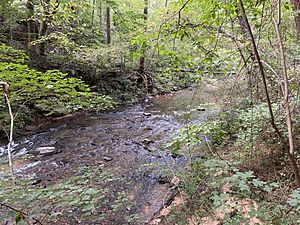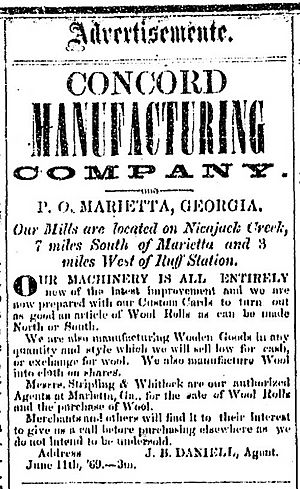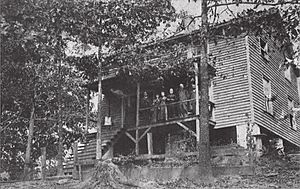Nickajack Creek facts for kids
Nickajack Creek is a stream in the U.S. state of Georgia. It flows through parts of Cobb and Fulton counties. The creek runs along the edge of the city of Smyrna and the town of Mableton. Nickajack Creek is a smaller stream that flows into a larger one, the Chattahoochee River.
Contents
A Look Back at Nickajack Creek
How the Creek Got Its Name
Many people believe that Nickajack Creek was named after a local Cherokee person. This person might have been the chief of a village that shared his name. One of the first times white European settlers learned about this village was from a map made in 1839. This map showed 'Nickajack Creek' joining the Chattahoochee River. This meeting point was south and west of an older settlement called Standing Peachtree.
Early Settlers and Mills
White European settlers began moving into the Nickajack Creek area in the mid-1800s. They created a community first known as 'Mill Grove,' and later as 'Nickajack.' The creek was very important because its strong flow could power many different types of mills. These included mills for grinding grain (gristmills), cutting wood (sawmills), and processing cotton and wool.
Robert Mable, who later founded the town of Mableton, helped build a gristmill for Henry Clay Ruff in the 1850s. Mable learned many skills for building mills while working with Robert E. Lee at Fort Pulaski. Both Ruff's home and his mill are still standing today in the part of the creek that runs through Smyrna.
A Civil War Battle
On July 4, 1864, soldiers from the Union and Confederate armies fought near Nickajack Creek. This battle is known as the Battle of Ruff's Mill.
The Concord Woolen Mill
After the Civil War, a company called the Concord Manufacturing Company built a woolen mill on Nickajack Creek in 1869. This mill was very important for the economy of Cobb County. Sadly, the mill caught fire in 1889. You can still see parts of the old mill today.
The Historic Covered Bridge
A special covered bridge crosses Nickajack Creek. It was first built around 1848 to 1850. This bridge is one of the few covered bridges left in Georgia. It is still used a lot today, even after it was made stronger to handle cars.
Ruff's mill, his house, the Concord woolen mill, and the covered bridge are all part of the Concord Covered Bridge Historic District. This area helps protect these important historical places.
Images for kids







